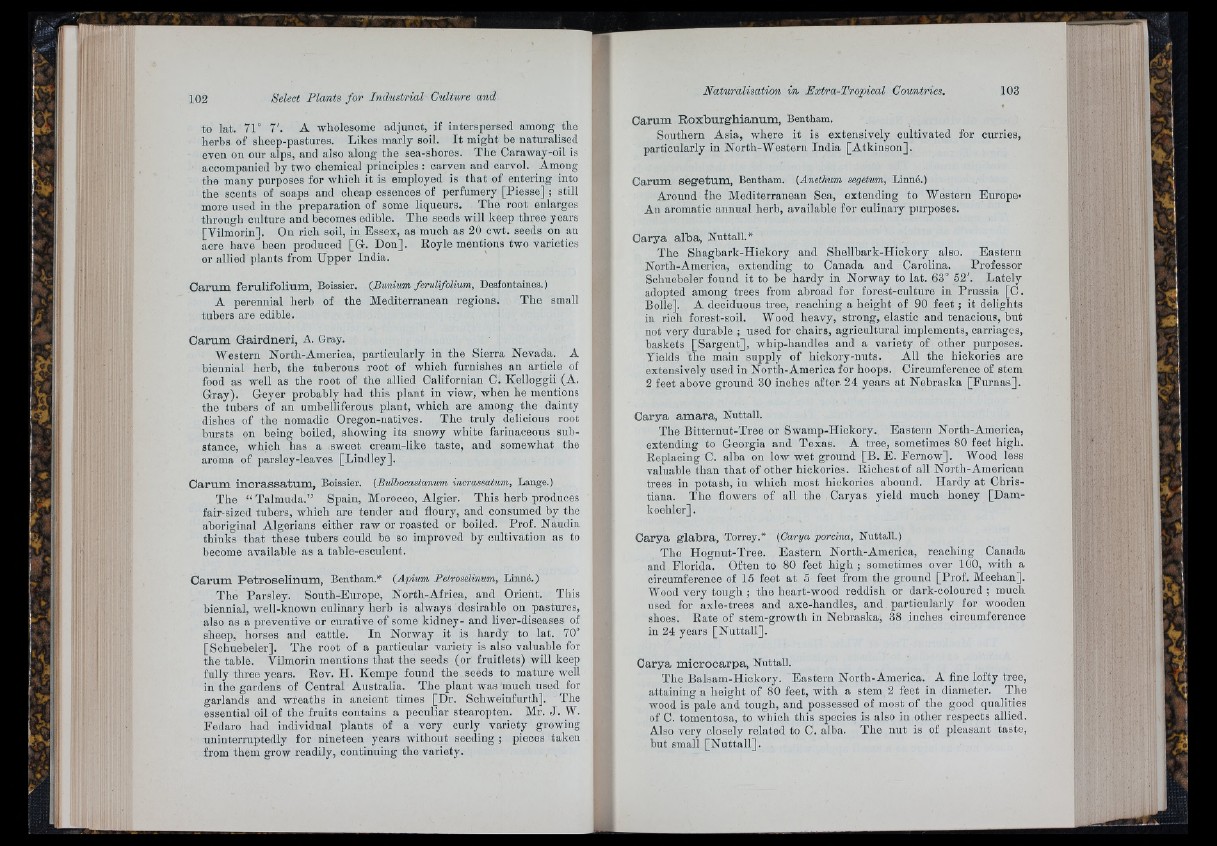
U ■■
i'i «
1 i
ii:
to lat. 71° 7'. A wholesome adjunct, if interspersed among the
herbs of sheep-pastures. Likes marly soil. I t might be naturalised
even on our alps, and also along the sea-shores. The Caraway-oil is
accompanied by two chemical principles : oarven aud carvol. Among
the many purposes for which it is employed is th a t of entering into
the scents of soaps aud cheap essences of perfumery [Piesse] ; still
more used in the preparation of some liqueurs. The root enlarges
througli culture and becomes edible. The seeds will keep three years
[Vilmorin]. On rich soil, in Essex, as much as 20 cwt. seeds on an
acre have“ been produced [G. Don]. Royle mentions two varieties
or allied plants from Upper India.
C a r u m f e ru lifo lium , Boissier. {Biinium feruUfolium, Desfontaines.)
A perennial herb of the Mediterranean regions. The small
tubers are edible.
C a r u m G a ir d n e r i, A. Gray.
Western North-America, particularly in the Sierra Nevada. A
biennial herb, the tuberous root of which furnishes an article of
food as well as the root of the allied Californian C. Kelloggii (A.
Gray). Geyer probably had this plant in view, when he mentions
the tubers of an umbelliferous plant, which are among the dainty
dishes of the nomadic Oregon-uatives. The truly delicious root
bursts on being boiled, showing its snowy white farinaceous substance,
which has a sweet cream-like taste, aud somewhat the
aroma of parsley-leaves [Lindley].
C a r u m in o r a s s a tu m , Boissier. (Buliocastanum incrassatum, Lange.)
The “ Talmiida.” Spain, Morocco, Algier. This herb produces
fair-sized tubers, which are tender and floury, and consumed by the
aboriginal Algerians either raw or roasted or boiled. Prof. Naudin
thinks th a t these tubers could be so improved by cultivation as to
become available as a table-esculent.
C a r u m P e t r o s e lin u m , Bentham.* (Apium Peiroselinum, Linné.)
The Parsley. South-Europe, North-Africa, and Orient. This
biennial, well-known culinary herb is always desirable on pastures,
also as a preventive or curative of some kidney- and liver-diseases of
sheep, horses and cattle. In Norway it is hardy to lat. 70°
[Schuebeler]. The root of a particular variety is also valuable for
the table. Vilmorin mentions that the seeds (or fruitlets) will keep
fully three years. Rev. H. Kempe found tlie seeds to mature well
in the gardens of Central Australia. The plant was much used for
garlands and wreaths in ancient times [Dr. Schweinfurth]. The
essential oil of the fruits contains a peculiar stearopten. Mr. J . W.
Fedaro had individual plants of a very curly variety growing
uninterruptedly for nineteen years without seeding ; pieces taken
from them grow readily, continuing the variety.
C a rum E o x b u r g h ia n u m , Bentham.
Southern Asia, where it is extensively cultivated for curries,
particularly in North-Western India [Atkinson].
C a rum s e g e tum , Bentham. (Anetlmm segetum, Linné.)
Around fhe Mediterranean Sea, extending to Western Europe*
An aromatic annual herb, available for culinary purposes.
C a ry a a lb a , Nuttall.*
The Shagbark-Hickory and Shellbark-IIickory also. Eastern
North-America, extending to Canada and Carolina. Professor
Schuebeler found it to be hardy in Norway to lat. 63° 52'. Lately
adopted among trees from abroad for forest-culture in Prussia [C .
Bolle]. A deciduous tree, reaching a height of 90 feet ; it delights
in rich forest-soil. Wood heavy, strong, elastic and tenacious, but
not very durable ; used for chairs, agricultural implements, carriages,
baskets [Sargent], whip-handles and a variety of other purposes.
Yields the main supply of hickory-nuts. All the hickories are
extensively used in North-America for hoops. Circumference of stem
2 feet above ground 30 inches after- 24 years at Nebraska [Furnas].
C a ry a am a r a , Nuttall.
The Bitternut-Tree or Swamp-Hickory. Eastern North-America,
extending to Georgia and Texas. A tree, sometimes 80 feet high.
Replacing C. alba on low wet ground [B. E. Fernow]. Wood less
valuable than th a t of other hickories. Richest of all North-American
trees in potash, in which most hickories abound. Hardy at Christiana.
The flowers of all the Caryas yield much honey [Dam-
koehler].
C a ry a g l a b r a , Torrey.* [Garya porcina, Nuttall.)
'Ih e IIognut-Tree. Eastern North-America, reaching Canada
and Florida. Often to 80 feet h ig h ; sometimes over 100, with a
circumference of 15 feet a t 5 feet from the ground [Prof. Meehan].
Wood very tough ; the heart-wood reddish or dark-coloured ; muc i
used for axle-trees and axe-handles, and particularly for wooden
shoes. Rate of stem-growth in Nebraska, 38 inches circumference
in 24 years [N u tta ll].
C a ry a m ic r o c a r p a , Nuttall.
'The Balsam-Hickory. Eastern North-America. A fine lofty tree,
attaining a height of 80 feet, with a stem 2 feet in diameter. The
wood is pale and tough, and possessed of most of the good qualities
of C. tomentosa, to wliioh this species is also in otlier respects allied.
Also very closely related to C. alba. The nut is of pleasant taste,
but small [N u tta ll].